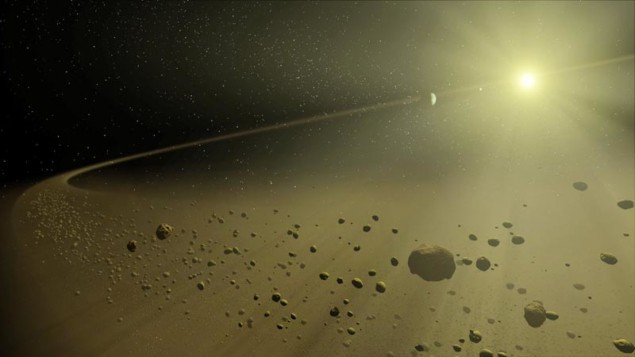
The solar system is up two million years older than previously thought, according to a pair of researchers in the US. Their work, which is based on dating a meteorite found nestled in the Sahara desert, also provides clues about the birth of the solar system, lending weight to the theory that a nearby supernova explosion triggered its formation
Most meteorites, other than the ones known to come from the Moon or Mars, are relics from the formation of the solar system. This latest example, labelled “Northwest Africa 2364”, has a mass of 1.5 kg and was purchased by a private dealer from a local in Morocco in 2004. Part of it ended up in the hands of Audrey Bouvier at Arizona State University in the US who found it to be 4568.2 million years old – the oldest solar system object ever discovered, and 0.3–1.9 million years older than the previously accepted age of the solar system.
Bouvier, along with co-author Meenakshi Wadhwa, also at Arizona State, analysed several radioisotope chains associated with elements found in the sample. Using the decays of 238U–206Pb and 235U–207Pb, which have half-lives of ~4.47 Gyr and ~704 Myr respectively, the pair were able to pin down the age of the space rock. “Radiogenic decay is at a constant rate over the aeons, which can be measured by physically counting particles,” explained Bouvier. This age was fine-tuned using the decay of 26Al–26Mg, which has a much shorter half life of ~0.73 Myr.
In the beginning, there was iron
The discovery of Northwest Africa 2364 is also helping to firm up scientists’ understanding of how our local neighbourhood formed. Conventional theory used to suggest that the Sun and its family of planets formed in near isolation, far away from other stars. However, in the last five years researchers have begun to suggest that this might not be the case due to high amounts of daughter isotopes from the decay of 60Fe found in previous meteorite samples. 60Fe can only be formed in the core-burning stage at the end of a star’s life before it goes supernova. This means that if 60Fe was present in the early solar system it had to be seeded there by a nearby supernova and the Sun couldn’t have formed in isolation after all. Bouvier and Wadhwa’s result only enhances this possibility.
“This research pushes back the start of the solar system by around a million years, so if you work backwards using radioactive decay there must have been a higher concentration of 60Fe at the beginning than previously thought, by about a factor of 2,” explained Jamie Gilmour, who researches solar system formation at the University of Manchester. “This makes it more necessary for a supernova to have seeded the solar system with it,” he added.
The findings are described in Nature Geoscience.



